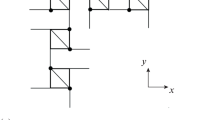Abstract
This paper reports on the results of crystal chemical analysis and computer simulation of the defect structure of potassium dihydrogen phosphate (KDP) containing impurities of bivalent and trivalent metals. It is shown that these impurities can form defect centers of different types: isolated centers formed by M 3+ and Ni2+ ions and, in part, by Co2+ ions at interstitial sites, chains composed of M 2+ impurity ions with radii from ≈0.65 to ≈1.1 Å, and centers created through the substitution of large-sized bivalent cations for potassium ions either with the formation of additional potassium vacancies or through the heterovalent isomorphism mechanism. The calculations are performed using different-type interatomic interaction potentials, and a comparative analysis of the results obtained is carried out.
Similar content being viewed by others
References
J. D. Gale, GULP: User Manual (Royal Institution and Imperial College, London, 1992–1994).
T. A. Eremina, V. A. Kuznetsov, T. M. Okhrimenko, et al., Kristallografiya 43(5), 906 (1998) [Crystallogr. Rep. 43, 852 (1998)].
T. A. Eremina, N. N. Eremin, N. G. Furmanova, et al., Kristallografiya 46(1), 82 (2001) [Crystallogr. Rep. 46, 75 (2001)].
T. A. Eremina, V. A. Kuznetsov, N. N. Eremin, et al., Kristallografiya 46(6), 1072 (2001) [Crystallogr. Rep. 46, 989 (2001)].
R. D. Shannon and C. T. Prewitt, Acta Crystallogr., Sect. B: Struct. Crystallogr. Cryst. Chem. 25, 925 (1969).
T. A. Eremina, V. A. Kuznetsov, T. M. Okhrimenko, et al., Kristallografiya 41(4), 717 (1996) [Crystallogr. Rep. 41, 680 (1996)].
Properties of Inorganic Compounds, Ed. by A. I. Efimov (Khimiya, Leningrad, 1983).
V. S. Urusov and N. N. Eremin, Phys. Chem. Miner. 22(3), 151 (1995).
U. Burkert and N. Allinger, Molecular Mechanics (American Chemical Society, Washington, 1982; Mir, Moscow, 1986).
K. Fujioka, S. Matsuo, T. B. Kanabe, et al., J. Cryst. Growth 181, 226 (1997).
Y.-J. Fu, Z.-S. Gao, S.-L. Wang, et al., Cryst. Res. Technol. 35(2), 177 (2000).
Author information
Authors and Affiliations
Additional information
__________
Translated From Kristallografiya, Vol. 47, No. 5, 2002, Pp. 819–824.
Original Russian Text Copyright © 2002 By Eremina, Eremin, Kuznetsov, Furmanova, Urusov.
Rights and permissions
About this article
Cite this article
Eremina, T.A., Eremin, N.N., Kuznetsov, V.A. et al. Simulation of defects formed by cations of bivalent and trivalent metals in the structure of potassium dihydrogen phosphate: A computational technique. Crystallogr. Rep. 47, 753–758 (2002). https://doi.org/10.1134/1.1509389
Received:
Issue Date:
DOI: https://doi.org/10.1134/1.1509389




